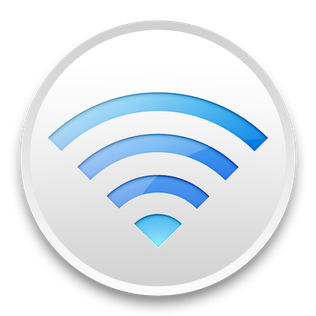Related Research Articles
AppleTalk is a discontinued proprietary suite of networking protocols developed by Apple Computer for their Macintosh computers. AppleTalk includes a number of features that allow local area networks to be connected with no prior setup or the need for a centralized router or server of any sort. Connected AppleTalk-equipped systems automatically assign addresses, update the distributed namespace, and configure any required inter-networking routing.

Wake-on-LAN is an Ethernet or Token Ring computer networking standard that allows a computer to be turned on or awakened from sleep mode by a network message.
A network operating system (NOS) is a specialized operating system for a network device such as a router, switch or firewall.

AirPort is a discontinued line of wireless routers and network cards developed by Apple Inc. using Wi-Fi protocols. In Japan, the line of products was marketed under the brand AirMac due to previous registration by I-O Data.
This page provides an index of articles thought to be Internet or Web related topics.

Bonjour is Apple's implementation of zero-configuration networking (zeroconf), a group of technologies that includes service discovery, address assignment, and hostname resolution. Bonjour locates devices such as printers, other computers, and the services that those devices offer on a local network using multicast Domain Name System (mDNS) service records.
Zero-configuration networking (zeroconf) is a set of technologies that automatically creates a usable computer network based on the Internet Protocol Suite (TCP/IP) when computers or network peripherals are interconnected. It does not require manual operator intervention or special configuration servers. Without zeroconf, a network administrator must set up network services, such as Dynamic Host Configuration Protocol (DHCP) and Domain Name System (DNS), or configure each computer's network settings manually.
The Internet Printing Protocol (IPP) is a specialized communication protocol for communication between client devices and printers. It allows clients to submit one or more print jobs to the network-attached printer or print server, and perform tasks such as querying the status of a printer, obtaining the status of print jobs, or cancelling individual print jobs.

CUPS is a modular printing system for Unix-like computer operating systems which allows a computer to act as a print server. A computer running CUPS is a host that can accept print jobs from client computers, process them, and send them to the appropriate printer.

A captive portal is a web page accessed with a web browser that is displayed to newly connected users of a Wi-Fi or wired network before they are granted broader access to network resources. Captive portals are commonly used to present a landing or log-in page which may require authentication, payment, acceptance of an end-user license agreement, acceptable use policy, survey completion, or other valid credentials that both the host and user agree to adhere by. Captive portals are used for a broad range of mobile and pedestrian broadband services – including cable and commercially provided Wi-Fi and home hotspots. A captive portal can also be used to provide access to enterprise or residential wired networks, such as apartment houses, hotel rooms, and business centers.

In computer networking, port forwarding or port mapping is an application of network address translation (NAT) that redirects a communication request from one address and port number combination to another while the packets are traversing a network gateway, such as a router or firewall. This technique is most commonly used to make services on a host residing on a protected or masqueraded (internal) network available to hosts on the opposite side of the gateway, by remapping the destination IP address and port number of the communication to an internal host.
In computer networking, a network service is an application running at the network application layer and above, that provides data storage, manipulation, presentation, communication or other capability which is often implemented using a client–server or peer-to-peer architecture based on application layer network protocols.
HP Jetdirect is the name of a technology sold by Hewlett-Packard that allows computer printers to be directly attached to a local area network. The "Jetdirect" designation covers a range of models from the external 1 and 3 port parallel print servers known as the 300x and 500x, to the internal EIO print servers for use with HP printers. The Jetdirect series also includes wireless print server models, as well as gigabit Ethernet and IPv6-compliant internal cards.
The Line Printer Daemon protocol/Line Printer Remote protocol is a network printing protocol for submitting print jobs to a remote printer. The original implementation of LPD was in the Berkeley printing system in the BSD UNIX operating system; the LPRng project also supports that protocol. The Common Unix Printing System, which is more common on modern Linux distributions and also found on macOS, supports LPD as well as the Internet Printing Protocol (IPP). Commercial solutions are available that also use Berkeley printing protocol components, where more robust functionality and performance is necessary than is available from LPR/LPD alone. The LPD Protocol Specification is documented in RFC 1179.

The Printer Working Group (PWG) is a Program of the IEEE Industry Standard and Technology Organization (ISTO) with members including printer and multi-function device manufacturers, print server developers, operating system providers, print management application developers, and industry experts. Originally founded in 1991 as the Network Printing Alliance, the PWG is chartered to make printers, multi-function devices, and the applications and operating systems supporting them work together better.
In computing, Microsoft's Windows Vista and Windows Server 2008 introduced in 2007/2008 a new networking stack named Next Generation TCP/IP stack, to improve on the previous stack in several ways. The stack includes native implementation of IPv6, as well as a complete overhaul of IPv4. The new TCP/IP stack uses a new method to store configuration settings that enables more dynamic control and does not require a computer restart after a change in settings. The new stack, implemented as a dual-stack model, depends on a strong host-model and features an infrastructure to enable more modular components that one can dynamically insert and remove.

AirPrint is a feature in Apple Inc.'s macOS and iOS operating systems for printing without installing printer-specific drivers.

Google Cloud Print was a Google service that allowed users to print from any Cloud Print-aware application on any device in the network cloud to any printer with native support for connecting to cloud print services – without Google having to create and maintain printing subsystems for all the hardware combinations of client devices and printers, and without the users having to install device drivers to the client, but with documents being fully transmitted to Google. Starting on July 23, 2013 it allowed printing from any Windows application, if Google Cloud Printer was installed on the machine.
HP ePrint is a term used by Hewlett-Packard to describe a variety of printing technologies developed for mobile computing devices, such as smartphones, tablet computers, and laptops.

SoftEther VPN is free open-source, cross-platform, multi-protocol VPN client and VPN server software, developed as part of Daiyuu Nobori's master's thesis research at the University of Tsukuba. VPN protocols such as SSL VPN, L2TP/IPsec, OpenVPN, and Microsoft Secure Socket Tunneling Protocol are provided in a single VPN server. It was released using the GPLv2 license on January 4, 2014. The license was switched to Apache License 2.0 on January 21, 2019.
References
- ↑ RFC1179 Line Printer Daemon Protocol, August 1990, edited by L. McLaughlin III.
- ↑ "AppSocket TCP/IP Protocol". LPRng Reference Manual. 26 Nov 2010. Retrieved 2017-09-06.
- 1 2 "Using Network Printers". cups.org. Retrieved 2017-09-06.
- ↑ Common Internet File System , Microsoft TechNet Library
- ↑ "Software update", iPad, UK: Apple
- 1 2 "AirPrint" (Press release). UK: Apple. September 15, 2010.
- ↑ Finnie, Ryan (November 13, 2010). "AirPrint & Linux" (how-to). Retrieved November 2, 2013.
- ↑ AirPrint: how to make it work for shared printers, TUAW, November 11, 2010
- ↑ "Printing from iPad AirPrint via Cups" (how-to). CC: Rho. Archived from the original on January 16, 2013. Retrieved November 2, 2013.